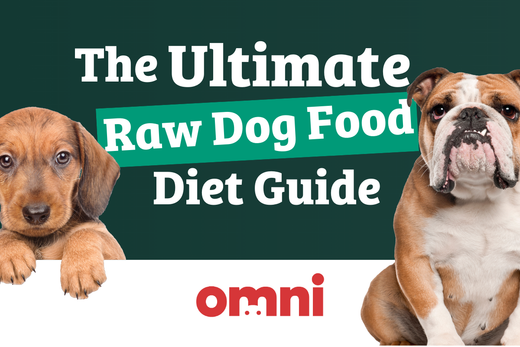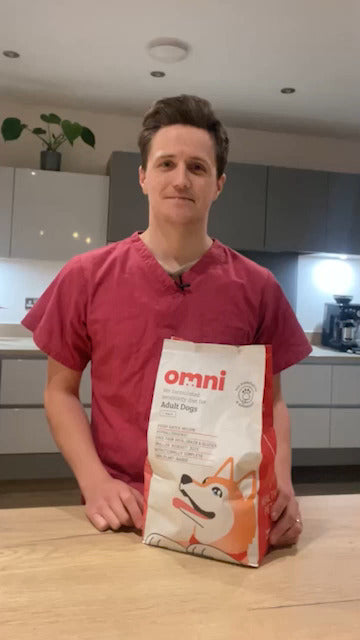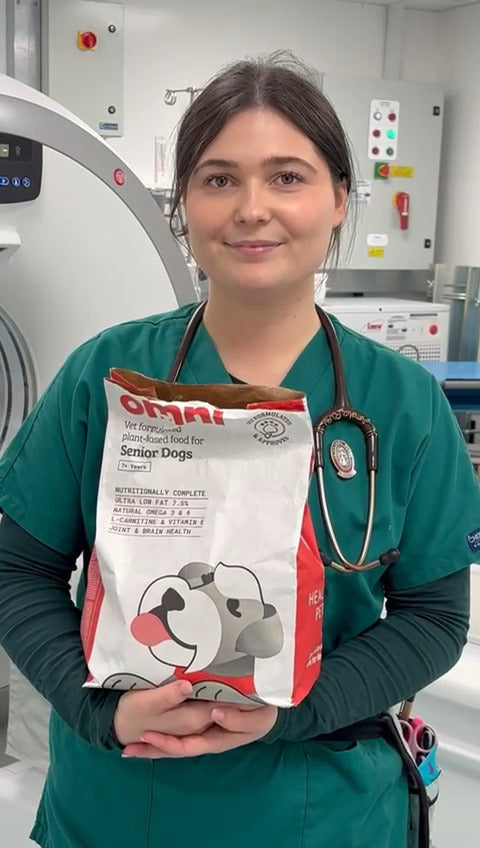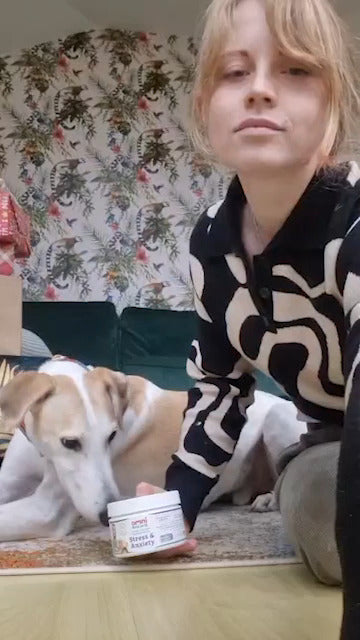The Raw Dog Food Diet: What You Need to Know (from a Vet)

If you’ve been on doggy social media recently, you’ll have noticed that there’s a huge conversation being had around feeding dogs raw food. Some people are all for it, while others are very much against it.
Raw feeding dogs is a controversial but somewhat common practice, so in this article we decided to break down the common myths and misconceptions around raw food diets for dogs and give you a vet’s perspective on the social media trend.
So, can dogs eat a raw food diet? We get a lot of questions like this in the clinic and in our free online vet appointments, and as we often see digestive issues, skin problems or tooth fractures on raw food diets, so I’ve put together a comprehensive guide on raw feeding dogs.
Make sure that you read the frequently-asked questions on raw-feeding dogs at the bottom of this article, so that you can make an informed decision to make sure your pup is happy and healthy, both in the short-term and in the long-term.
What is the Raw Food Diet for Dogs?
The raw food diet consists of raw, uncooked meat, either exclusively or just as a major portion of the diet - this usually looks like
- Meat, including muscle meat that is still on the bone
- Organ meats like livers, kidneys, and tripe (the stomach of an animal)
- Bones, either whole or ground up
A raw food diet for dogs can also contain some fruits and vegetables like carrots or blueberries, as well as eggs, herbs, seeds, oils, and a small amount of grains.
Typically, a raw food diet is low in carbohydrates, very low in fibre, and if not properly balanced can cause deficiencies or imbalances in nutrient levels like calcium, phosphorus, vitamin D, vitamin A, iodine, zinc, copper, and more.
Those in favour of the raw food diet often call it the ‘BARF’ diet, which stands for the ‘Biologically Appropriate Raw Food’ diet. Adding the phrase ‘Biologically Appropriate’ is usually done to give some scientific credibility to the diet, but you will find that a majority of vets will recommend against feeding a raw food diet for a variety of reasons. We will cover the reasons why this is the case in this article.
The Prey Model
Some people who feed their dogs raw food diets will opt for something called ‘the prey model’ rather than a BARF diet. The prey model entails feeding your dog whole prey animals, such as an entire rabbit, fur, feet and all. Again, this is not recommended by most vets.
Is the raw food diet good or bad for dogs?
The raw food diet is not recommended by a majority of vets. Some dog guardians and raw food advocates claim that they have seen great results on a raw food diet; however, as with anything, anecdotal evidence is always only part of the picture. Here, we aim to give you a full breakdown of the raw food diet, good, bad, and ugly.
Pros of the raw dog food diet
There are some reported benefits on a raw food diet. Dog guardians who are pro-raw food will often claim benefits like:
- Improved coat condition and glossiness
- Increased muscle mass and decreased risk of obesity
- Cleaner teeth
- Better quality of stools
- A ‘more natural’ diet
Of course, many advocates of many different types of dog food will say similar things - indeed, we notice all of the above with dogs on Omni! - so it’s important to actually drill down into the data on each point to find out whether raw feeding actually does have any advantage over traditional and vet-formulated dog food like Omni.
Is raw feeding a natural diet for dogs?
Other than specific improvements in coat, teeth, and digestion, one of the commonest arguments for raw feeding - whether the BARF model or the prey model - is that it is a more natural diet for dogs. Supposedly, this is because dogs are carnivores, and therefore not only can eat raw meat, but they should eat raw meat. Or so the argument goes.
However, this perspective neglects to mention that dogs have been domesticated alongside humans for well over ten thousand years, so have picked up many of the same dietary traits as us, including our gut microbes that help us digest starchy plant matter.
In fact, even wolves (the carnivorous precursors to dogs) are technically omnivores, as many wolves survive much of the year simply eating berries and leaves.
When you add in the fact that dogs now have around 30 genes to help them digest different plant-based compounds and that studies have shown dogs do better on plant-based diets than any other… well, you start to tear down the ‘dogs are carnivores’ theory, and therefore get rid of one of the major pillars behind raw feeding dogs.
Can raw food help with obesity in dogs?
Some vets have commented that they have perceived a lower risk of obesity in dogs on raw meat diets. As almost half of dogs in the UK are overweight or obese, reducing incidence of obesity is obviously a good outcome for overall dog health. However, there are numerous reasons why this might be.
For example, some vets have wondered whether the raw food diet is so expensive that very few people can afford to overfeed on raw food. If you are limited portion sizes, then your dog will naturally lose weight, as they will expend more energy each day than they take in from food calories.
Additionally, a raw food diet might be good for weight loss because it is very low in carbohydrates, which are actually important energy sources for both humans and dogs. Carbohydrates also help to store water, as each gram of glycogen (carbs stored in the body) comes with three grams of water attached. This is why humans are able to lose weight on a low-carb diet, though weight loss alone is not the only metric of health.
We should be very careful about using weight loss alone as a way to measure how healthy a diet is.
Cons of the raw dog food diet
There are many risks and other downsides to a raw food diet. We’ll separate those into different sections and discuss each in turn.
Risks of the raw dog food diet
The raw dog food diet has many risks associated, including:
- Bacterial and parasitic contamination
- Nutritional imbalances and deficiencies
- Intestinal obstruction or perforations
- Tooth decay and fracture
Bacteria in raw dog food
Raw, uncooked meat commonly has dangerous, infectious bacteria like E. coli, Salmonella and Campylobacter which the cooking process would normally help to kill off.
The risk here isn’t only to dogs, but to people, too: humans can catch these infections simply from just stroking healthy-looking pups that are shedding harmful bacteria from their raw-fed
diets. This makes raw-feeding for dogs even more ill-advised in households with young people, older people, and people who are immunocompromised.
Up to 54% of these dogs may be shedding bacteria that are already resistant to antibiotics, too, thanks to the huge quantities of antibiotics used in animal agriculture that breed newer, more dangerous, and more resistant strains of bacteria.
A number of worms and parasites are also only killed when meat is cooked. As a result of dangerous potential microbial and parasitic contamination, raw food has caused serious illness and even death in both dogs and their owners and has resulted in repeated raw food recalls in recent years.
In addition, dogs who are immunocompromised (e.g., dogs who have diabetes or are on immunosuppressant medication) are particularly at risk from a raw-fed diet, as the bacterial infections that may be fought off by a dog with a healthier immune system will post a significant threat to a dog with a weakened immune system.
The contamination risk alone is reason enough not to raw feed your dog, in the opinion of the vets here at Omni, but there are plenty of other risks, too.
Nutritional deficiencies and imbalances caused by a raw dog food diet
Everybody worries about nutritional deficiencies already, but it is a little-known fact that having too much of a nutrient or having the wrong ratios or balances of nutrients can be just as harmful.
Speaking of nutritional imbalances, the data on raw feeding is worrisome:
One study of 95 home-prepared samples of raw food rations showed that 60% of the rations had significant dietary imbalances, and many of the rest had ‘minor’ imbalances.
In another study, 94% of raw meat-based diets had at least 1 nutritional imbalance, and two-thirds (66%) had more than 5 imbalances.
Most commonly, these were imbalances in dietary calcium and phosphorus (both too high and too low), as well as imbalances in vitamins A and D, copper, zinc, and iodine.
Puppy dogs fed with raw diets are exposed to risks of imbalanced calcium and phosphorus, causing developmental issues with their bone structures from an early age.
Choking hazards and tooth fractures with raw food diets
One of the most direct risks of a raw food diet - especially one containing meat ‘on the bone’ - is the risk of whole bones or bone shards either causing damage to your dog’s teeth or actually entering the digestive tract and wreaking havoc in their internal organs.
Amongst these risks is peritonitis, an inflammation of the stomach caused by damage from indigestible bone shards.
Cooked bones are more brittle and dangerous than uncooked bones, but regardless of cooking status, both carry a significant risk.
Numerous dogs have choked to death on bones in the past, and so most vets consider giving dogs a bone - despite how cartoonish it may seem! - to be an unsafe practice.
Other drawbacks of the raw dog food diet
- Raw feeding your dog can be incredibly expensive
- Preparing fresh meat every day can be difficult and time-consuming
- Many dogs are unwilling to eat raw meat
Raw food diets are difficult
Most people find it quite difficult to store, prepare, and feed a raw-fed diet to their dog. For sanitation reasons alone, it can be very difficult to keep your kitchen hygienic with that quantity of raw meat around. As we mentioned above, too, freezing raw meat and then thawing it again does not necessarily kill the harmful microbes that pose a serious health risk to you, your dog, and your family.
Raw food diets are expensive
To add to that, raw fed diets for dogs are typically far more expensive than any other. It can quite easily cost £5-10 per day to feed just one medium-sized dog, depending on the exact constituents of the diet. Meat and animal products are amongst the most expensive foods there are due to their resource-intensive nature, meaning that most dog guardians find that raw feeding their dog has a huge financial cost.
Raw food can be unpalatable
Lastly, many dogs simply are not keen on the taste or texture of raw meat. Raw meat can be chewy, messy, cold, and difficult for many dogs to eat and digest. There is always a high percentage of dogs who will simply not take to raw meat - and even for those that do, remember: just like doctors don’t recommend sweets and chocolate to children even though the kids like them, vets don’t recommend raw meat to dogs simply because some dogs enjoy it. There are many more factors to overall health.
When you look at the bigger picture, raw meat diets are never advisable.
How do you switch a dog to the raw dog food diet
Omni’s vets do not recommend switching to a raw food diet for dogs.
However, as with any diet change, we recommend starting slowly and always in consultation with a vet. Preferably, keep a food diary to log any symptoms or behaviours you start to notice and when you notice them.
Omni’s feeding guidelines can be found here LINK.
How much food will I need to feed my dog on this diet?
To tell you the truth, no amount of raw meat is truly safe for dogs, just as no amount of raw meat is truly safe for humans. The risks of infection and disease are too high and can’t be mitigated by processes like freezing and thawing. As a result, we are not comfortable advising the amount of raw food you should feed your dog - because the answer is “none”!
Generally speaking, however, dogs need to eat around 2% of their body weight in food each day, though this varies based on age and stage as well as the kind of food you are feeding. Always consult the packaging from the dog food manufacturer.
How much does the raw food diet cost?
Raw food usually costs more money to feed your dog than even the most premium kibble brands on the market.
Typically, a raw food diet can cost around £5 per dog per day, though it varies depending on style of food.
You can feed your dog for less than this on a hybrid diet that mixes raw food with kibble.
Again, however, vets generally do not recommend raw food for reasons that are far more salient than the price factor: raw food is simply unsafe for dogs.
What nutrients will my dog get from a raw food diet?
Raw food diets usually have an unbalanced nutrient profile, meaning that they supply too little of some nutrients (causing deficiencies) and too many of other nutrients (causing imbalances).
Nutrients that are present in a raw food diet include:
- Fat
- Protein
- Amino acids
- Vitamin A
Raw meat also usually contains high quantities of:
- Phosphorus
- Iron
- Copper
- Magnesium
- Zinc
That being said, balance of nutrients is often more important than the sheer amount of them present.
What happens if my dog has too much phosphorus?
To take just one example of a harmful nutrient imbalance, consider calcium and phosphorus. Usually, these two nutrients work in tandem to create bone.
You typically need up to 2 times as much calcium in your dog’s diet as you do phosphorus; however, raw meat is much higher in phosphorus, meaning that your dog will (relatively speaking) not be ingesting enough calcium to balance out the phosphorus.
While this seems like a minor point, puppies raised on a raw food diet while their bones are growing are therefore more likely to develop orthopaedic problems like weak, brittle, or malformed bones.
In addition, dogs who are liable to kidney failure are advised to avoid raw meat due to the high concentration of elements like phosphorus which can overwhelm kidneys and force them to work harder than they should.
Risks of a high-fat diet for dogs
The high fat content of a raw food diet can cause problems for dogs at risk of pancreatitis, which is a painful and potentially lethal condition in which the pancreas becomes dangerously inflamed.
Dairy products, which are typically high in fat, are not recommended for dogs for this reason. Raw meat falls into the same category. This is why you should not feed your dog bacon, grease, ham and many other animal products - and why increasingly many humans are swearing off eating meat for their health, too!
What nutrients are missing from a raw dog food diet?
There are a variety of nutrients that are missing from a raw food diet for dogs.
The raw food diet is typically low in:
- Fibre
- Carbohydrates
- A healthy balance of essential fatty acids
- Vitamin E
- Probiotics
- Vitamin D
- Phytonutrients and antioxidants
The above is not an exclusive list, but represents the most common and most important oversights in any raw-fed diet.
Each of these nutrients is an essential part of helping your dog live a long, happy, healthy life. Unfortunately, a raw fed diet lacks almost all of them in any significant quantity.
Raw food diets lack carbohydrates and fibre
For example, carbohydrates are only found in plant-based compounds, not in meat; fibre, a type of carbohydrate, is essential for keeping the gut running smoothly and avoid either diarrhoea or constipation.
Like in humans, fibre is a hugely important nutrient that often gets overlooked on a raw-fed diet. Carbohydrates are also great sources of energy for dogs, as they can be broken down straight into glucose that is used to fuel their muscles during long walks, runs, or play sessions.
There are ways to increase the carbohydrate and fibre on a raw food diet - for instance, by including vegetables, fruits and grains.
However, notably these are the ingredients that we at Omni include in our novel proteins diets as standard, alongside many other important phytonutrients, with far superior health outcomes to a typical raw food diet!
Will I need to give my dog any supplements on this diet?
Our vets highly recommend supplementing your dog if you are feeding a raw food diet. This is because there are a huge number of nutrients that they are likely to miss out on on a raw food diet, such as:
- Fibre
- Carbohydrates
- A healthy balance of essential fatty acids
- Vitamin E
- Probiotics
- Phytonutrients and antioxidants
The best supplement to give is something like the Homecooking supplement, which acts almost like a multivitamin.
Dogs on raw food diets should also use probiotic supplements, considering that raw food has none of the fibre or ‘good bacteria’ that a dog’s gut needs to operate properly.
Is there anything my dog shouldn’t eat on the raw dog food diet?
There are some foods which your dog may start developing an issue with whilst eating on a raw food diet, including:
- Bones, whether cooked or raw
- Raw meat at risk of contamination
- Large quantities of dairy products
- Certain medications
Why can my dog not have bones on a raw food diet?
Bones can snap whilst being gnawed on while your dog, causing them to swallow sharp shards that can wreak havoc in their digestive system.
This happens even more often with cooked bones, which are more brittle, but even uncooked or raw bones can cause damage. Your dog’s teeth can also chip or break off when eating hard objects like bones.
How do I know if raw meat is contaminated?
The problem is - you can’t! Not easily, anyway, and not without a laboratory full of equipment. Bacteria are microscopic in size, and many will be inside the meat rather than simply on the surface, making it very difficult to sanitise.
Even freezing the meat for a period of time before thawing it again fails to actually kill the bacteria in the majority of cases.
This poses not just a risk to your dog, but also to you and your family; this is the primary reason why most vets will recommend strongly against a raw fed diet for dogs.
Can my dog have dairy products?
Many dogs are lactose intolerant. Cow’s milk is not a natural product for a dog to have, and most dogs will have lost their capacity to digest lactose as adults once they no longer need milk from their own mothers.
Dog milk contains quite a different nutrient profile to cow’s milk, too, meaning that substituting like-for-like doesn’t work effectively and may leave your dog with nutrient deficiencies and imbalances - not to mention at risk of conditions like pancreatitis due to the high fat content of dairy products like cheese in particular.
While dairy is commonly included in raw fed diets for dogs, most vets will recommend against this practice, or advise that dogs should only have a limited, infrequent amount of dairy as a treat.
Can my dog take medication on a raw food diet?
Generally, yes, your dog should take any medications prescribed by their vets. However, make sure that your vet knows that your dog is on a raw fed diet if you have chosen to go down this route, as many medications are interfered with by particular constituents of a raw food diet and won’t work as effectively as a result.
For example, certain medications cannot be given alongside foods that are rich in calcium like some animal products, including meat and cheese.
Examples of such medications include certain antibiotics that bind to calcium from your dog’s diet and which renders the antibiotic ineffectual.
How safe is the raw food diet for dogs?
A raw food diet for dogs is not generally deemed safe for dogs. Many vets do not recommend a raw food diet for the following reasons:
- Bacterial infections from raw food for both dogs and humans
- Nutrient deficiencies or imbalances from raw food
- Tooth decay and fracture from gnawing on bones, both cooked and uncooked
In fact, a raw food diet is probably the most unsafe way to keep your dog fed purely due to the risk of bacterial contamination that affects around 33% of raw food samples tested.
What are the main hazards of a raw food diet?
As we discussed above, the main hazard of significant concern to both dog health and human health is bacterial contamination. Around one in three (33%) of samples of raw food or dogs are affected by bacterial contamination or parasites like worms.
As well as this, it is very hard to balance a dog’s diet from a nutritional standpoint whilst limiting yourself only to raw meat, which has a very skewed nutritional profile (see above for our discussion of calcium and phosphorus levels, for example). The high fat content of a raw food diet can also lead to pancreatitis and generalised digestive difficulty.
It is common to see diarrhoea or constipation in dogs fed on raw food diets due to the lack of pre- and probiotics in raw meat - despite the fact they are often advertised as “biologically appropriate” raw food diets!
Finally, there is a major physical risk with dogs chewing on bones, both cooked and uncooked, due to the risk of them ingesting shards that can perforate the walls of their digestive tracts. This has been known to be fatal in dogs in the past.
How do I know if raw dog food is good quality?
As we mentioned above, it is very hard to tell ‘good’ quality raw food from the worst of the worst - mostly because many of the risk factors for your dog’s health (and your own) are microscopic. Our vets recommend avoiding raw food wherever possible and feeding a diet that you know is sanitary, effective and safe.
What scientific research has been done on the raw dog food diet?
Plenty of papers have been published on raw dog food diets, considering that the practice of raw-feeding dogs stretch back many decades if not centuries. However, in all that time, there are no scientifically proven benefits of a raw food diet for dogs.
As the VCA Veterinary Hospital group in the USA put it,
“There are no clinically proven benefits of a raw food diet, but there are documented hazards and risks.”
One of the most important pieces of evidence that vets use to warn dog guardians about the dangers of a raw fed diet for dogs is that one in three (33%) of raw food samples tested turned out to contain infectious pathogens like Salmonella or E. coli.
Is a raw food diet better than a plant-based diet for dogs?
A plant-based diet is significantly healthier for dogs than a raw meat-based diet.
Forget the old tropes around how dogs are carnivores (they’re not! Dogs are omnivores). Forget, too, that picture of a wolf eating a freshly-killed deer. Our dogs are no longer wolves - having evolved alongside humans for well over ten thousand years, dogs are dietary omnivores who are more than capable of digesting plant matter.
Indeed, one study found that an expertly-formulated, nutritionally-complete plant-based diet for dogs could be the optimal diet for canine health. Dogs on complete vegan diets live on average 18 months to 2 years longer than dogs on conventional meat-based diets.
Using novel proteins sourced from natural ingredients like plants, algae and yeast, our vets are able to provide far superior (and safer!) nutrition for dogs than a typical store-bought pouch of raw meat can provide.
Do vets recommend a raw food dog food diet? Thoughts from Veterinarian Dr. Guy (MRCVS):
As vets, we always respect the guardian’s wishes when it comes to what to feed your pet, and we rarely if ever will put our foot down. Even if we do, we can’t enforce our recommendations!
Still, it’s important to know that vets only want what is best for your dog, and we will tell you what scientists tell us. And, so far, science tells us simply that raw food is an unsafe form of nutrition for your dog which does not actually provide them with all the nutrients they need.
Even though raw feeding has arguably become more “trendy” over time, with groups and pages popping up everywhere on social media, we have to keep in mind that the science has not actually changed.
In fact, more and more science comes out every day supporting the shift to plant-based diets for dogs - something which isn’t quite as trendy (yet!), but I am certainly starting to see a strong movement towards novel protein alternatives to traditional (and raw) dog food.
Frequently Asked Questions on the Raw Dog Food Diet
Can dogs eat raw meat?
Technically, yes, but most vets - including the Omni vet team - will advise against feeding your dog raw meat due to the high risk of bacterial infection to both you and your dog, as well as nutritional imbalances that usually result.
My dog refuses to eat raw food. What should I do?
This is common, as raw food can be very unpalatable to dogs as a result of its taste and texture. Vets do not recommend raw food due to a variety of health concerns (see above), so if your dog finds it unpalatable, it is advisable to stop feeding raw food and transition to a different diet instead.
Can my dog still eat treats on this diet?
Generally, yes, your dog can have treats. A raw diet doesn’t have to be exclusively raw, although some voices online will advocate for this. Most vets do not recommend following a raw food diet for dogs.
How should I store raw food for my dog?
Due to the high risk of infection and disease spread from raw meat storage, we recommend storing raw food far away from other food, preferably wrapped up, sealed, and in a freezer. Make sure to regularly clean any spaces that have contact with raw meat in case of contamination spread. Be aware that even freezing raw meat will not necessarily kill the bacteria that poses a risk to your dog, however, which is why most vets will advise strongly against the practice of raw feeding.
How do I know if my dog is getting a balanced diet?
Consult with a vet - Omni offers free vet consultations online so you can check exactly this. The chances are, if you are preparing your dog’s meals at home and/or feeding a raw food diet, your dog will not be getting the correct balance of nutrients. We often advise the use of a Homecooking supplement in order to correct this balance, but it is usually advisable to transition your dog onto a nutritionally-complete, vet-formulated diet like Omni.
I switched to raw food and my dog has sickness & diarrhoea - help!
Unfortunately, this is very common with dogs on raw food diets, and is part of the reason why many vets will not recommend raw diets in the clinic or in online vet consultations. We recommend taking advice from a veterinarian. It could be that your dog has an allergy or intolerance to one or many constituent parts of their raw food diet.
Does freezing raw food kill the bacteria?
Unfortunately, freezing raw meat does not kill all the bacteria and parasites - it only enders them dormant. However, upon thawing, these microorganisms are able to replicate again and become infectious.
Can a puppy eat a raw dog food diet?
Generally, vets will advise against feeding any dog a raw food diet. Puppies can be particularly at risk from infections as they do not have developed immune systems yet. In addition, puppies may be more adversely affected by nutrient imbalances such as an imbalance between calcium and phosphate because their tissues and bones are still actively growing. A nutritional imbalance at this stage could have ramifications for your dog’s health throughout their life.
My dog was fine on a raw diet at first, but suddenly started vomiting or digesting it poorly. Help!
Our vets find that this is a very common occurrence in dogs. Overexposure to potential allergens like animal proteins can cause the immune system to become more sensitive over time. This is why some dogs may start off great on raw but then get loose stools, itchy skin, waxy ears, and potentially cause vomiting and other symptoms too. It is also possible that your dog has picked up an infection from a batch of raw meat that has become rotten or infected. We advise seeking urgent veterinary advice in this case.
Can my diabetic or immunocompromised dog have a raw food diet?
Dogs that suffer from diabetes or another condition that may render them immunocompromised should avoid a raw-fed diet, as the risks of picking up a bacterial infection from uncooked meat are even greater. Always consult with your vet before making any changes to your immunocompromised dog’s diet.
Article Updates & Reviews
Article Last Updated on:
14/10/24
Written By:
Dr. Guy, (MRCVS)
Medically Reviewed By:
Sophie Kay (MRCVS) ?
Copy Edited By:
Rory Cockshaw, BA (Cantab.)







 85 Great Portland Street, 1st Floor, London, W1W 7LT United Kingdom
85 Great Portland Street, 1st Floor, London, W1W 7LT United Kingdom